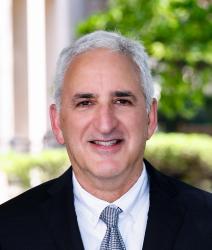President Donald Trump delivered his second State of the Union address to Congress on February 5, 2019. In the speech, the president highlighted his administration’s recent accomplishments and outlined its policy priorities for the year ahead, which include a continued pursuit for funding a wall along the southwestern border.
Below, experts from across Brookings offer share their reactions to the president’s speech and offer their analysis on the policy issues that were emphasized or notably absent.
Scott R. Anderson, David M. Rubenstein Fellow, Governance Studies
Absent from this year’s State of the Union was nearly any discussion of the ambitious and consciously disruptive international agenda that the Trump administration has set out in public remarks over the past year. Along with Secretary of State Mike Pompeo and National Security Advisor John Bolton, President Trump has aggressively criticized U.S. involvement in international institutions, withdrawn from a record number of treaties, threatened to restructure the U.S. relationship with NATO, proposed an ambitious new regional security strategy for the Middle East, and promised the “deal of the century” for Israelis and Palestinians. Aside from a brief reference to increasing NATO members’ financial contributions, however, President Trump made no mention of these initiatives.
This omission suggests that President Trump’s commitment to these policy initiatives may be far weaker than some in the administration have suggested. To some extent this is unsurprising: several of these initiatives have proven controversial even within the president’s own party, and may be seen as political liabilities leading up to the 2020 presidential elections. But it does signal that the Trump administration’s willingness to expend political capital advancing them is likely limited. This is important for Congress, where there are substantial bipartisan concerns with these initiatives. By erecting legal barriers and exercising oversight, Congress can increase the political costs of many aspects of the Trump administration’s foreign policy agenda, even if it can’t stop them outright. President Trump’s seemingly limited commitment to these efforts suggests that such efforts may be more successful than one might expect. In other words, when it comes to reining in the most problematic aspects of the Trump administration’s foreign policy, the State of the Union confirmed that the ball is solidly in Congress’s court.
Jessica Brandt, Fellow, Foreign Policy
President Trump used the State of the Union to press for hardline immigration policies, including the construction of wall along the southwestern border. According to analysis by the New York Times, 15 minutes of the 82-minute speech were devoted to the subject. He mentioned the border 14 times. He mentioned the wall eight times. He referred to Russia only twice, nearly within the same breath. MS-13 got as much attention.
As my colleague Tom Wright has observed, while Trump’s national security strategy highlights the return of great power competition (it accuses Russian leadership of “using information tools in an attempt to undermine the legitimacy of democracies,” calling Russia a “revisionist power”), Trump himself rarely addresses the subject. Instead, he consistently hammers immigration.
As they formulate their foreign policies and prepare for future debates, aspiring 2020 presidential candidates should take note. The president gets to set the framework for a national dialogue, and if past is prologue, immigration will be front and center. His remarks in the leadup to the midterms and this State of the Union offer us a preview of what’s to come.
Daniel L. Byman, Fellow, Foreign Policy
President Trump mourned those lost in the Tree of Life synagogue shooting in October in his speech. The attack, which killed 11 people, was the deadliest anti-Semitic attack in U.S. history. Remembering the dead is important, but it’s not enough. As I’ve written, the president needs to prioritize right-wing terrorism, treating it as a major domestic threat. Right-wing terrorism is exacerbating divisions in America, playing into the broader political debate where white supremacist and other radical ideas are returning. To follow up his speech, the president should announce a major program to go after right-wing extremists, denouncing them repeatedly and also allocating more resources to fight them and directing security agencies to be more aggressive.
Giovanna De Maio, Visiting Fellow, Foreign Policy
There are a few features of this SOTU that are in common with Italy and the rise of populism in Europe.
1. Populism is replacing the center-left parties that were not able to fully address social inequalities and discomfort. In this speech, President Trump fully rejected socialism; nevertheless, he addressed the lower and middle class, parental leave, and reducing the cost of drugs and education. It is very similar to what is happening in Italy with the Five Star Movement: in rejecting any kind of ideology, its strength relies in the attention to the forgotten people. It is very hard to tell how much of this is true and will be fully translated into effective policies. Regardless, the mere fact that forgotten people entered into the political narrative makes a given leader gain points.
2. The narrative on illegal immigration is similar on both sides of the Atlantic. The Italian minister of interior Matteo Salvini, leader of the League party, takes from Trump the slogan of “Italians first” and insists on the same mental association between immigration and terrorism and criminal activities.
3. The sovereigntist choice of pursuing great power politics over diplomacy (e.g., withdrawing from the Iran nuclear agreement and INF tready, trade wars, an ambiguous narrative on NATO) might seem to achieve some results on the surface for the U.S. but is totally counterproductive for countries like Italy.
Vanda Felbab-Brown, Senior Fellow, Foreign Policy
Although President Trump portrayed his speech as seeking common ground, his remarks on immigration and the wall on the U.S.-Mexico border continued to be inflammatory and exaggerated. Contrary to his claims, the U.S. border with Mexico is not “lawless.” There has been no increase of crime on the U.S. side of the border. U.S. border cities remain among the safest in the United States, and it is not because walls or fences. Migrants, including undocumented migrants, commit violent crimes at much lower rates than native-born Americans.
Yes, there is a humanitarian crisis on border as Central Americans seek asylum in the United States. But that needs to be solved through expanding the capacity of U.S. immigration courts. It also requires providing much-improved shelters for migrants, not freezing detention centers that separate children from parents or force asylum seekers to work for minimum wage.
Nor do migrants steal U.S. jobs. Most jobs migrants from places such as Central America fill jobs that native-born Americans do not want: difficult or unpleasant jobs, such in the fish cutting industry, agriculture, or hospice care. Although President Trump finally acknowledged the many benefits legal immigrants bring to the United States, his administration has systematically and radically sought to reduce legal immigration. Such policy measures have been undertaken even though migrants to the United States have been critical for enlarging the U.S. workforce to offset reduced productivity growth and support entitlements for the elderly as a greater number of them depend on a smaller number of native-born Americans.
Strikingly absent from President Trump’s speech segment on Afghanistan was an affirmation of support for the Afghan government and a declaration of the commitments that negotiations with the Taliban need to include in a Taliban-Afghan government deal. Instead, President Trump oddly stated that the United States is holding talks with a number of Afghan groups, including the Taliban. Such inept phrasing will worry the Afghan government, already profoundly uncertain about whether the United States will simply cut a unilateral deal with the Taliban and dash out of Afghanistan, risking collapse of the Afghan government—either as a result of the Taliban’s military pressure or political instability.
The vagueness of the statement is all the more striking given how actively President Ashraf Ghani has sought U.S. assurances to the contrary. Equally significant, President Trump did not provide any assurance that if a negotiated settlement with the Taliban is not reached, the United States will maintain the wherewithal to continue militarily supporting the Afghan government and the political freedoms and civil liberties the Afghan people have achieved, however greatly imperfect such freedoms are. Whether President Trump meant it or not, both the Afghan government and the Afghan people will be only more worried after his State of the Union remarks.
William G. Gale,Senior Fellow, Economic Studies and Aaron Krupkin, Senior Research Analyst, Economic Studies
Last night, President Trump lauded that the Tax Cuts and Jobs Act “virtually ended the estate tax.” While the legislation did not repeal the estate tax, it doubled the exemption to $11.2 million for single filers and $22.4 million for couples. Taxes on estates and gifts have shrunk dramatically over the past 40 years. Less than 0.1 percent of all estates are subject to the estate tax, down from a peak of 7.65 percent in 1977. But by taxing wealth transfers from one generation to the next, they play an important role in making taxes more progressive and slightly offsetting disparities in opportunity across economic classes.
Critics argue (including President Trump in his address) that the taxes adversely affect entrepreneurship and family farms, sometimes claiming that the children of business owners and farmers who die are forced to sell their inherited businesses and farms to pay the tax. There’s little to no evidence to support these claims, however, nor was there even in earlier years when the exemption was much lower than today. Several analyses, including by the American Farm Bureau Federation and New York Times, did not reveal a single farm that went out of business due to estate tax liability. In fact, only 80 small businesses and farms faced the estate tax in 2017, paying a total of $30 million, equal to 0.15 of 1 percent of total estate tax revenue.
As baby boomers die, they could potentially transfer massive amounts of resources to the next generation. If left untaxed, those transfers will exacerbate the inequality that has widened over the past 40 years and fuel additional revenue shortfalls.
President Trump also lauded that Congress and his administration “passed a massive tax cut [in 2017] for working families.” While the Tax Cuts and Jobs Act (TCJA) is projected to reduce federal revenues by well over $1 trillion over the next decade, the tax cuts are highly skewed towards high-income households, and middle-class families, on average, will not experience a major change in tax liability. According to Tax Policy Center estimates, TCJA reduced taxes on average by $1,610 in 2018—a 2.2 percent increase in after-tax income. But the boost in after-tax income was only 0.4 percent for households in the lowest quintile, compared with 2.9 percent for those in the top quintile, more than 4 percent for those in the 95th–99th percentile, and 3.4 percent for taxpayers in the top 1 percent.
Moreover, most of the provisions aimed at middle-class households, such as the individual rate cuts, the increase in the standard deduction, and the increase in the child credit, are slated to expire after 2025. Several of the provisions whose benefits are skewed towards higher-income households, including the corporate tax cut, are permanent.
As a result, by 2027, the bottom 60 percent of the income distribution, on average, is projected to experience a drop in after-tax income relative to a scenario without the legislation, while the top 1 percent of households is expected to receive an increase in after-tax income of 0.9 percent.
Aaron Klein, Fellow, Economic Studies
Rebuilding America’s infrastructure was once again paid lip service, delivered to generate applause but with no follow through. When an issue is a top priority a president will frequently use the State of the Union to challenge Congress to pass a legislative proposal the administration puts forth. Instead, President Trump subtly put the onus on Congress, stating that “Congress is eager to pass an infrastructure bill” and only promising that he would “work with Congress.” This is Washington speak for not investing the political capital necessary to overcome the long-standing road block to infrastructure investment: how to pay for it. Here are the three options that Congress and the president have if they want to actually do something on infrastructure, which remains the road not taken.
Jung H. Pak, Senior Fellow, Foreign Policy
President Trump in his State of the Union address announced that his second summit with North Korean leader Kim Jong-un will take place February 27-28 in Vietnam. He admitted that “much work remains to be done,” an understatement given that there has been little progress on North Korean denuclearization since the last summit in Singapore in June 2018. Since then, the regime has explicitly refused to take significant denuclearization steps until the U.S. provides “corresponding measures,” such as sanctions removal. It is a tactic to put the onus of progress on Washington and buy time for the regime as Kim Jong-un continues to portray North Korea as a responsible nuclear weapons power. Meanwhile, a steady stream of reports have indicated that North Korea is continuing to quietly advance its nuclear weapons program, which is more worrisome for U.S. policy because the president appears to have a low bar for progress, citing that North Korea has not conducted nuclear or ballistic missile tests in the past 15 months.
President Trump did not once mention U.S. allies South Korea and Japan during his discussion of North Korea, continuing to place himself at the center of the narrative on North Korea policy. He reiterated his “good” relationship with Kim Jong-un and claimed that “If I had not been elected president of the United States, we would right now … be in a major war with North Korea.” While touting the personal rapport might be a way to keep Kim engaged and invested in maintaining the momentum for diplomacy, it advantages Kim because he sees opportunities to exploit any divisions and fissures in U.S. relationships with regional partners. The North Korea issue is a regional and global problem, and it would be prudent for the president to remember that the path to ultimate success on achieving North Korean denuclearization requires close coordination and effort with our regional partners and allies.
Jonathan Rauch, Senior Fellow, Governance Studies
As was the case in 2018, President Trump used his State of the Union speech to show the kind of dignity and restraint that have so often been conspicuous by their absence. He also showed that he is a true ideological magpie. Nodding left: lower drug prices; new infrastructure; reciprocal tariffs; paid family leave; eliminating HIV/AIDS; more money for cancer; economic empowerment of women in developing countries (say what?). Nodding right: school choice; abortion restrictions; the wall, the wall, the wall. For doves: peace talks and troop withdrawals in Afghanistan and Syria; making friends with North Korea. For hawks: Iran; scrapping a nuclear arms treaty; America First! You name it, it was in there. Immigration and the border wall received disproportionate attention. Otherwise, however, the speech did not so much define his agenda as diffuse it.
Richard Reeves, Senior Fellow, Economic Studies
The announcement on a national paid leave policy, a sign of Ivanka Trump’s policy influence, came as a welcome surprise. Working families are under a time squeeze as well as a money squeeze, with both men and women juggling work with childcare and often eldercare too. A federal paid leave program has long been a desire of many Democrats, but treated with skepticism by many Republicans and conservative scholars. A Brookings-AEI Working Group on Paid Leave (led by Belle Sawhill and Aparna Mathur) has issued two reports on how to move forward on a paid leave policy. The key is to ensure that it helps middle-class and working-class families, since most managers and professionals are covered. But if the president is serious about this, and can get enough GOP Senators onside, it is possible we will see the U.S. join the majority of advanced economies in having a national floor for paid leave.
President Trump’s pledge to “end the HIV epidemic in America” by 2030 was a bold one. An interim goal is in some ways even more ambitious: to reduce new infections by 75 percent over five years. Centers for Disease Control head Dr. Robert R. Redfield has said the agency would make an aggressive effort to diagnose infections in “hot spot” areas, 48 counties in particular. What Mr. Trump did not say is that this means focusing resources and attention on gay and bisexual men, and black gay men especially. CDC research suggests that one in two gay black men will become infected with HIV, compared to one in 132 white heterosexual men. Of course modern medicine means that HIV and AIDS are no longer the threat they once posed if—and this is a big if—patients reliably take their medication. Success here will require a concentration of health resources, a renewed effort to reduce homophobia, and investment in compliance. But if this effort is properly funded, well led, and given policy latitude to do what is necessary, the lives of thousands of black men could be saved.
Adie Tomer, Fellow, Metropolitan Policy Program
After publicly teasing for weeks that infrastructure would stand alongside health care, immigration, and trade as a major focus area of the 2019 State of the Union, President Trump and the administration effectively punted. That’s not hyperbole: infrastructure received effectively three sentences in the entire speech and included no specifics. Compare this to the clear delineation of challenges and goals around prescription drugs, trade dynamics, and border interventions. It was a missed opportunity.
The question is where this leaves the administration in a potential federal infrastructure debate. The administration is certainly not bereft of ideas, as its 50-plus page plan continues to live on its website and includes many innovations that could inform a broader package. Yet the president’s silence in the SOTU likely cedes the public agenda-setting to House Democrats and specifically Representative Peter DeFazio (D-Ore.), who chairs the Transportation and Infrastructure Committee. He and his team now have a broad opportunity to set public expectations about what the future of federal infrastructure policy could be. The question is whether it can square with conservative values, all while the 2020 election clock begins to tick louder each month. It’s a tall task.
Nicol Turner-Lee, Fellow, Governance Studies
In an aspirational State of the Union speech, President Trump began by acknowledging the millions of people who were watching, but failed to offer an apology to the hundreds of thousands of federal workers, contractors, businesses and other entities that were affected by the longest running government shutdown. This was an obvious omission on the part of the White House, who fails to see value in the people that work to make this nation great.
When the president pivoted to his border wall, words that referenced certain immigrants as “ruthless coyotes,” “cartels”, “drug dealers,” and other less desirable descriptors were spewed. And, similar to his unwilling deference to federal workers, he breezed past the ongoing separation of immigrant children – some of them legal – from their families.
With this type of racial rhetoric and politically-motivated jargon, will the president ever find bipartisan agreement on issues? Probably not.
Although, the recent bipartisan adoption and passage of the FIRST STEP Act (S. 795), which passed overwhelmingly in the Senate, may provide some guidance on how to get there. The Act, which was widely supported across parties, will offer incentives for ex-offenders returning back to their communities to get job-ready, while addressing issues in sentencing, prisoner release and other rehabilitation efforts.
The support for the Act was strengthened through partnerships with civil society actors, including media brand and mogul Kim Kardashian, and objective conversations among lawmakers. These stakeholders sought to not only understand the problems associated with ex-offender re-entry, but also return human dignity back to the formerly incarcerated.
As once again demonstrated in the 2019 SOTU, fiery language, bold threats and little regard for people will not move the needle on bipartisan agreement for this president, nor will it mute the rhetoric which has already made it somewhat impossible to achieve.
Jon Valant, Fellow, Governance Studies
The president uttered one sentence— 16 words—about education on Tuesday night. It was a vague and passing reference to the need to “pass school choice for America’s children.” The only real purpose of that line was to check a box, ensuring that he didn’t deliver an 82-minute SOTU address without mentioning education.
In reality, hardly anyone wants to see the Trump administration active in K-12 education. Republicans decried the hands-on approach of the Obama administration, believing it overreached by taking on issues more appropriately left to schools, local and state governments, or Congress. Congressional Republicans have shown no desire to pass major federal school choice legislation despite being broadly supportive of school choice. Democrats are content to see Trump steer clear of K-12 education— and increasingly unlikely to embrace school choice reforms.
In my view, the federal government could address a number of challenges in American schools, but much of that work involves policymaking outside of education. For example, by helping families out of poverty and addressing gun violence, policymakers could mitigate the problems that arrive at the doorsteps of U.S. schools.
Darrell West, Vice President and Director, Governance Studies
The most surprising aspect of the State of the Union was the complete absence of any discussion of technology policy. Over the past year, President Trump has complained about liberal bias on social media platforms, the danger of technology transfers to China, and limited competition in key digital markets. But there was no mention of these issues and no policy ideas to address them. The absence of a policy agenda in this sector is noteworthy because it suggests that although Trump is concerned about these problems, he plans no major technology policy changes. He seems content with the status quo even though he complains about various issues. New technology ideas clearly rank well below the proposals he did make in terms of safeguarding the southern border, protecting U.S. trade, restraining pharmaceutical drug prices, increasing research on childhood cancers, eliminating HIV/AIDS, and being tough on Iran. The closest he came to discussing technology was in celebrating America’s moon landing from 50 years ago.
The Brookings Institution is committed to quality, independence, and impact.
We are supported by a diverse array of funders. In line with our values and policies, each Brookings publication represents the sole views of its author(s).

















Commentary
Brookings experts react to Trump’s second State of the Union
February 6, 2019